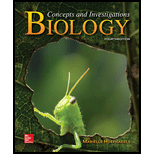
Concept explainers
Introduction:
The major distinction between cells is of them being prokaryotic or eukaryotic. Within the eukaryotes major distinction is done based on the presence or absence of cell wall.
Answer to Problem 1MCQ
Correct answer:
The cell wall is not present in all the cell types. Therefore, option c. is correct.
Explanation of Solution
Reason for the correct statement:
The cell wall is not observed in all the cells. It is found in all the prokaryotes, plant cells and
Option c. is given as “Cell wall”.
As, “cell wall is a feature not found in all cells”, is the right answer.
Hence, option c. is correct.
Reasons for the incorrect statements:
Option a. is given as “Proteins”.
Proteins are found in each and every cell. It is the
Option b. is given as “Ribosomes”.
Ribosomes are the site of protein production and hence are found in all the cell types. So, it is a wrong answer.
Option d. is given as “Cell membrane”.
The cell membrane is found in all the cells. A cell may not have the cell wall or capsid but all have the cell membrane. So, it is a wrong answer.
Hence, options a., b., and d. are incorrect.
The cell wall is a cellular feature not found in all the cells.
Want to see more full solutions like this?
Chapter 3 Solutions
Biology: Concepts and Investigations
- In one paragraph show how atoms and they're structure are related to the structure of dna and proteins. Talk about what atoms are. what they're made of, why chemical bonding is important to DNA?arrow_forwardWhat are the structure and properties of atoms and chemical bonds (especially how they relate to DNA and proteins).arrow_forwardThe Sentinel Cell: Nature’s Answer to Cancer?arrow_forward
- Molecular Biology Question You are working to characterize a novel protein in mice. Analysis shows that high levels of the primary transcript that codes for this protein are found in tissue from the brain, muscle, liver, and pancreas. However, an antibody that recognizes the C-terminal portion of the protein indicates that the protein is present in brain, muscle, and liver, but not in the pancreas. What is the most likely explanation for this result?arrow_forwardMolecular Biology Explain/discuss how “slow stop” and “quick/fast stop” mutants wereused to identify different protein involved in DNA replication in E. coli.arrow_forwardMolecular Biology Question A gene that codes for a protein was removed from a eukaryotic cell and inserted into a prokaryotic cell. Although the gene was successfully transcribed and translated, it produced a different protein than it produced in the eukaryotic cell. What is the most likely explanation?arrow_forward
- Molecular Biology LIST three characteristics of origins of replicationarrow_forwardMolecular Biology Question Please help. Thank you For E coli DNA polymerase III, give the structure and function of the b-clamp sub-complex. Describe how the structure of this sub-complex is important for it’s function.arrow_forwardMolecular Biology LIST three characteristics of DNA Polymerasesarrow_forward
 Concepts of BiologyBiologyISBN:9781938168116Author:Samantha Fowler, Rebecca Roush, James WisePublisher:OpenStax College
Concepts of BiologyBiologyISBN:9781938168116Author:Samantha Fowler, Rebecca Roush, James WisePublisher:OpenStax College
 Human Physiology: From Cells to Systems (MindTap ...BiologyISBN:9781285866932Author:Lauralee SherwoodPublisher:Cengage Learning
Human Physiology: From Cells to Systems (MindTap ...BiologyISBN:9781285866932Author:Lauralee SherwoodPublisher:Cengage Learning Human Biology (MindTap Course List)BiologyISBN:9781305112100Author:Cecie Starr, Beverly McMillanPublisher:Cengage Learning
Human Biology (MindTap Course List)BiologyISBN:9781305112100Author:Cecie Starr, Beverly McMillanPublisher:Cengage Learning





